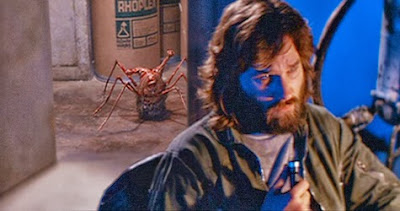A group of researchers in the arctic must adapt to survive as an unknown creature begins to kill them off one by one, its shape is unknown, its origin is a mystery, and its only description is an indescribable thing. John Carpenter’s “The Thing” is a Lovecraftian horror masterpiece captures its audience in a realm of isolation and paranoia from beginning to end. It’s a film with an abundance of imagination and talent behind it, but found itself heavily criticized upon its initial release in 1982. The cold embrace of the audience would follow the film after its release, until now.
The film’s plot centers on an all-male group of researchers stationed in a research compound somewhere in Antarctica. The brutal weather blows snow and ice across their facilities. With the only warmth coming from the gray-palette claustrophobic hallways keeping the compound standing. With two weeks of radio silence, the team remains inside of the compound; isolated from the rest of the world. The only interaction they received outside of the cold protected warm embrace of each other, is a Norwegian helicopter with a passenger shooting a rifle at a wolfdog.
The helicopter lands and explodes near the United States research facility killing the pilot, the passenger approaches the facility, speaking norwegian, and shooting frantically at the dog’s direction. Accidentally wounding one of the team members, the passenger is shot and killed. Leaving the wolfdog in their possession. The team then investigates the origin of the helicopter and finds those who worked with the pilot and the passenger, discovering a bloody and burnt compound with bodies frozen in their last moments. One who ended his life and another with two people appearing melted and fused together wearing an expression of pure terror and confusion. Unable to identify it, the team takes the remains only to be thrusted into a morbid situation of their own at their compound.
The film’s atmosphere is drenched with paranoia. The core of visual storytelling is determined by what is in frame and what is not. John Carpenter’s “The Thing” fully embraces this and uses the presence and absences of characters to tell the story. With careful actions during certain scenes and careful use of dialogue, their dissection brings even the smallest answers to the audience. Essentially pushing audiences into thinking about what they are seeing. Doing so has added to its merit but relies on the audience’s attention to determine a film’s success, unfortunately major audiences were unexpectedly cold and neglectful to the film itself.
The lack of character backstories brought the audience schlock horror. With many complaints of the film centering on the idea that the characters are just there to die. Along with a general distaste for the film’s overall cynical tone and subject matter. With animals being executed, people being assimilated or trying to kill each other out of paranoia, with special effects by Rob Rottin being masterfully gory and organic. This was too much for an audience fresh off of the whimsical and uplifting nature of Spielberg’s E.T. general interest in the film was hindered.
The iconography of popular films from the 1980s has burrowed itself in popular culture. Many of which had merit with high-level concepts and engaging stories. However the most commercially successful quality was their accessibility. With comedy and likable characters any audience member could root for. John Carpenter as a filmmaker has been defined by his inaccessibility throughout his career. From “Halloween” to “Big Trouble in Little China,” John Carpenter’s inaccessibility has put him at odds with Hollywood. “The Thing” was the pinnacle of this curse following the imaginative director. Audience reaction to this, caused him to fully embrace his cynical nature and actively desire to make films for his own pleasure.


